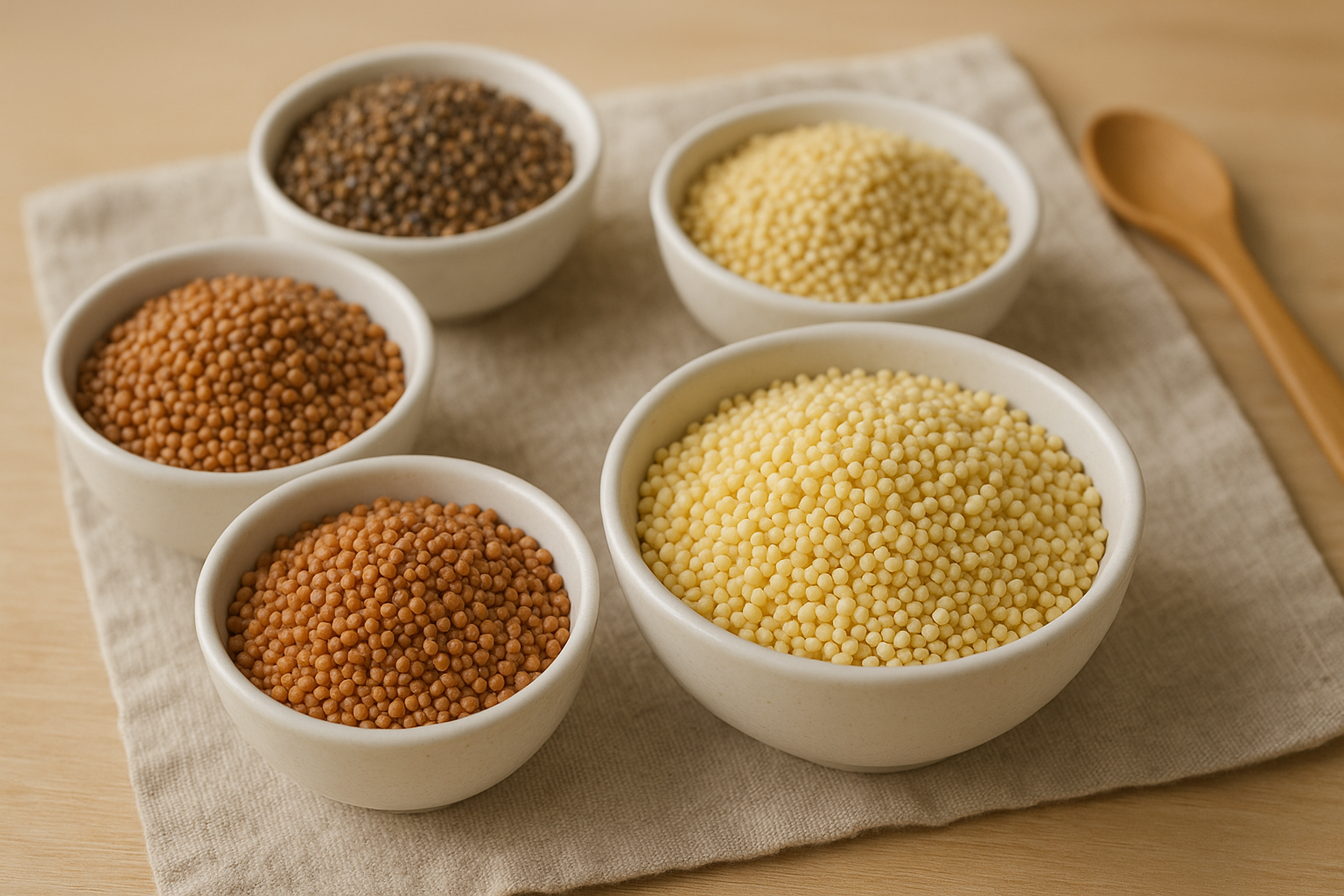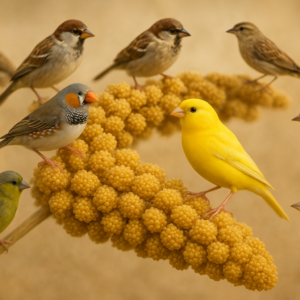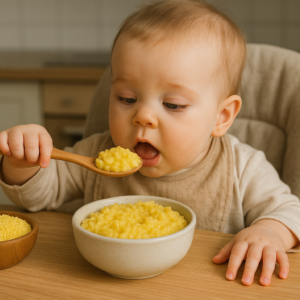Choosing the right first foods for your baby can feel overwhelming. Among the many options available today, millets stand out as ancient grains that offer modern nutrition. These tiny seeds pack powerful health benefits and gentle digestion properties that make them perfect for growing babies.
Parents across India have trusted millets for generations as weaning foods. Today, nutritionists worldwide recognize their value for infant nutrition. Let’s explore which millets work best for babies and how to introduce them safely.
What Makes Millets for Babies a Smart Choice?
Millets are small-seeded grasses that have nourished communities for over 5,000 years. They are gluten-free and contain various nutrients such as carbohydrates, proteins, fiber, vitamins, and minerals. These qualities make them gentler on tiny tummies compared to wheat or other common grains.
All types of millet offer carbohydrates, fiber, and protein, in addition to calcium, folate, vitamin B6, and zinc. These nutrients support everything from bone growth to brain development. The grain’s smooth texture when cooked also helps babies learn to swallow solid foods.
Many parents wonder if their baby can digest grains properly. Millets possess smooth digestion properties, making them easier on developing digestive systems than many other grains. CMS Industries recognizes the agricultural importance of these traditional grains and supports their cultivation across India.
When Can Babies Start Eating Millets?
Millet can be introduced to babies after they cross six or eight months. Most pediatricians recommend starting solid foods around six months when babies show readiness signs. These include sitting with support, showing interest in food, and losing the tongue-thrust reflex.
Start slowly with just 1-2 teaspoons of well-cooked millet porridge. Watch your baby for three days before adding any new food. This waiting period helps you spot any sensitivity or allergic reaction.
Age guidelines for serving millets:
- 6-8 months: Thin, smooth porridge made from ragi or little millet
- 8-10 months: Thicker porridge with mashed vegetables
- 10-12 months: Millet pancakes, dosa, or finger foods
- 12 months and above: Various millet preparations with diverse flavors
Best Millets for Babies: A Complete Breakdown
Ragi (Finger Millet)
Ragi tops the list as the most recommended millet for babies. Ragi has about 30 times as much calcium in Rice and has 10 times as much fiber than Rice. This makes it exceptional for building strong bones and teeth.
Ragi is an excellent source of iron, which helps treat iron-deficiency anemia in babies. Iron deficiency affects nearly 40% of children between 6 and 59 months globally, making ragi’s iron content particularly valuable.
Ragi works well as a first millet because it’s gentle and easy to digest. You can prepare it as porridge, mix it into pancakes, or use it to make traditional South Indian dishes like idli and dosa.
Foxtail Millet
Foxtail millet is rich in good carbs and B vitamins and boosts energy. The B vitamins help babies convert food into energy while supporting brain health. Its mild, slightly sweet taste makes it appealing to young palates.
This millet suits babies around 7 months and older. The smooth texture works well in porridges and khichdi preparations. CMS Industries, as an agricultural products supplier, emphasizes quality grain sourcing for optimal nutrition.
Little Millet
Little Millet is a mild millet with fiber that’s good for babies with tummy issues and makes a great choice for early weaning, especially for babies 6 months and older. Its gentle nature helps prevent digestive discomfort.
Little millet contains components that help increase good cholesterol levels, supporting heart health from early childhood. The complex carbohydrates release energy slowly, keeping babies satisfied longer.
Pearl Millet (Bajra)
This type of millet is renowned for its ability to help manage and prevent type 2 diabetes and is extremely rich in magnesium. While diabetes prevention might seem distant for babies, building healthy eating habits early matters.
Pearl millet works well for babies 8 months and older. The higher fat content in pearl millet provides sustained energy, perfect for growing babies with boundless curiosity. Its slightly coarser texture makes it better suited for older babies who can handle more textured foods.
Kodo Millet
Kodo millet is known for its antioxidant properties and supports brain and nerve development. The slightly chewy texture makes it perfect for babies 8 months and older who are learning to chew.
Kodo millet is a champion for calcium and promotes gut health through dietary fiber content. This combination supports both bone development and digestive wellness.
Barnyard Millet
Barnyard millet has fewer calories but is high in iron and is great for babies who need lighter meals during sickness or teething. Its easy digestibility makes it a good choice when babies feel unwell or show signs of food sensitivity.
This millet often gets recommended for babies with allergies or sensitive stomachs because it’s one of the least allergenic grains available.
Learn the Best 15 Benefits of Yellow Millet for Baby to support healthy growth and nutrition — please read this blog!
Health Benefits of Millets for Baby Development
Strong Bones and Teeth
Millet contains a high proportion of calcium and regulates the bone development process of small and growing children. Calcium needs are high during infancy when babies triple their birth weight and grow rapidly.
Better Digestion
Millet contains soluble and insoluble fiber, which helps improve baby constipation. The fiber content keeps the digestive system moving smoothly without causing gas or bloating when introduced gradually.
Improved Sleep Quality
Millet is a complex carbohydrate that helps in producing serotonin, which can help calm your baby’s mood and help them sleep well. Better sleep means better growth and development.
Preventing Anemia
Iron deficiency remains common in young children. Millets provide plant-based iron that, when combined with vitamin C-rich foods, gets absorbed well by the body. Soaking, germination, and fermentation of millets can improve iron bioavailability.
Muscle Growth
Millet is a good protein source that supports cell development and tissue repair. As babies become more active, they need protein for muscle development and recovery.
How to Safely Introduce Millets for Babies
Start Small and Watch
Begin with just 1-2 teaspoons of smooth millet porridge once daily. After introducing a new millet, wait for 3 days before adding anything else and look out for rashes, vomiting, or unusual bowel changes.
Age-Appropriate Portions
- 6-8 months: 1-2 tablespoons per day
- 9-12 months: 3-4 tablespoons per day
- Over 12 months: Quarter to half cup per day
Preparation Tips
Always cook millets thoroughly until soft and mashable. Loose grains of millet are more likely to scatter in the mouth, which can cause gagging or coughing. Mix cooked millet with broth, breast milk, or vegetables to help grains stick together.
For better digestion, soak millets for 30 minutes before cooking. Some parents prefer using sprouted millet flour, which has enhanced nutrient availability.
What to Avoid
Never add salt, sugar, or honey to millet preparations for babies under 12 months. Keep preparations simple and let babies experience the natural taste of grains.
Millets like pearl and foxtail generate heat which harms the body. Balance these by serving with cooling foods like cucumber, yogurt, or buttermilk as babies grow older.
Potential Side Effects and Precautions
While millets are generally safe, some babies may experience minor issues:
Digestive Discomfort
Because of their high fiber content, digestive reactions like bloating or gas can happen, especially if introduced too early (before 6 months) or served in large amounts. Start with small amounts and increase gradually.
Rare Allergies
Allergies to millet are rare, but can be severe. Watch for skin rashes, unusual crying, or digestive upset after first exposure. Stop feeding the millet and consult your pediatrician if you notice any reaction.
Thyroid Concerns
It is advisable to limit millet consumption by children who are iodine deficient or have an underactive thyroid. If your baby has been diagnosed with thyroid issues, discuss millet consumption with your doctor.
Simple Millet Recipes for Babies
Basic Ragi Porridge (6 months+)
Mix 2 tablespoons of ragi flour with half a cup of water. Stir continuously while cooking on low heat until thick and glossy. Add a teaspoon of ghee before serving. The smooth consistency works perfectly for first-time eaters.
Foxtail Millet Khichdi (8 months+)
Combine soaked foxtail millet and moong dal in equal parts. Cook with water until soft, adding turmeric and a drop of ghee. Mash well before serving. This protein-rich meal provides complete nutrition.
Little Millet Porridge with Vegetables (9 months+)
Cook little millet until soft, then mix with mashed carrots or pumpkin. Add breast milk or formula to reach desired consistency. This colorful meal introduces new flavors while maintaining familiar textures.
Bajra and Banana Mash (10 months+)
Prepare bajra porridge and mix with mashed ripe banana. The natural sweetness makes this combination appealing to babies. Serve warm for breakfast.
Storing and Preparing Millet Safely
Buy millets from trusted sources like CMS Industries, which supplies quality agricultural products. Store whole millets in airtight containers in cool, dark places. They stay fresh for several months when stored properly.
Do not store millets in the refrigerator if it is not yet cooked. Moisture in refrigerators can affect the grain quality and lead to spoilage.
Prepare fresh batches of millet porridge for each feeding. Baby food should never sit at room temperature for more than an hour. If you must store prepared food, refrigerate immediately and use it within 24 hours.
Always check packaged millets for expiration dates. Organic, minimally processed millets retain more nutrients than highly refined versions.
Millets vs. Other First Foods
Many parents compare millets with quinoa or rice cereal. Quinoa may get the superfood spotlight, but millet is locally grown, easy to digest, and far more sustainable to source regularly in Indian households.
Rice cereal has been a traditional first food, but millets offer more nutrients per serving. The higher calcium, iron, and protein content in millets support growth better than plain rice.
Millets are considered to be the least allergic grains, making them safer choices for babies with family histories of food allergies.
Building Healthy Eating Habits Early
Introducing millets for babies does more than provide nutrition. It builds taste preferences that last into adulthood. Children who eat diverse grains early accept more foods later.
Starting young helps them develop a taste for millet, which can replace grains like rice and wheat to make regular Indian dishes healthier. This early exposure creates lifelong healthy eating patterns.
A balance of grains, pulses, lentils, vegetables, fruits, nuts, seeds, and probiotics is essential for the proper growth and development of your child. Millets should be part of a varied diet, not the only grain.
Choosing Quality Millets Matters
The quality of millets affects both nutrition and safety. CMS Industries, a leading agricultural products manufacturer and supplier in India, emphasizes the importance of sourcing high-quality grains. Their commitment to quality ensures that millets retain maximum nutritional value.
Look for organic millets when possible, especially for baby food. Organic farming methods avoid pesticides and chemicals that could affect developing systems. Check for proper packaging and sealing to ensure freshness.
Conclusion
Millets for babies offer time-tested nutrition that modern science continues to validate. These ancient grains provide the calcium, iron, protein, and fiber that growing babies need. From ragi’s bone-building calcium to little millet’s gentle digestive properties, each variety brings unique benefits.
Start slowly, watch your baby’s response, and gradually include different types of millets in their diet. Remember that breast milk or formula remains the primary nutrition source during the first year, with solids complementing rather than replacing milk feeds.
By choosing quality millets from reliable suppliers and preparing them properly, you give your baby a strong nutritional foundation. These early food choices shape lifelong eating habits and health outcomes. Millets connect your baby to generations of healthy eating while supporting their growth with complete, balanced nutrition.
FAQs About Millets for Babies
Can I give millet to my 6-month-old baby?
Yes, you can introduce millets after 6 months once your baby shows readiness for solids. Start with smooth, well-cooked ragi or little millet porridge. Begin with 1-2 teaspoons and watch for any reactions over three days. Always consult your pediatrician before introducing new foods, especially if your baby has any health concerns or family history of allergies.
Which is the best millet to start with for babies?
Ragi (finger millet) is the best first millet for most babies because of its high calcium and iron content combined with easy digestibility. It has a mild taste that babies accept readily. Little millet also works well as a starter grain due to its gentle effect on the stomach. Both options provide excellent nutrition without overwhelming developing digestive systems.
How much millet should I feed my baby daily?
For babies 6-8 months old, start with 1-2 tablespoons of millet porridge once daily. Babies 9-12 months can have 3-4 tablespoons per day. After 12 months, you can offer quarter to half cup servings. Always observe your baby’s appetite and digestion. Some days babies eat more, some days less, and both patterns are normal for healthy development.
Can millets cause constipation in babies?
Millets usually help prevent constipation because of their fiber content. Sometimes babies might experience constipation if millets are introduced too quickly or without enough fluids. Ensure your baby drinks adequate water or breast milk along with millet meals. If constipation occurs, reduce the amount temporarily and include water-rich fruits like papaya or pear in the diet.
Are millets better than rice cereal for babies?
Millets offer more nutritional benefits than plain rice cereal. They contain higher amounts of calcium, iron, protein, and fiber. Millets are also gluten-free like rice but provide more diverse nutrients. Rice cereal works as a first food, but rotating between millets and rice gives babies broader nutrition. Both can be part of a healthy weaning diet without one completely replacing the other.





